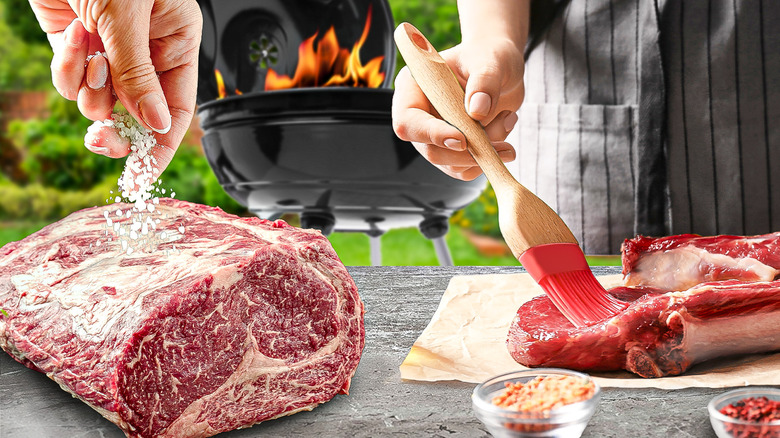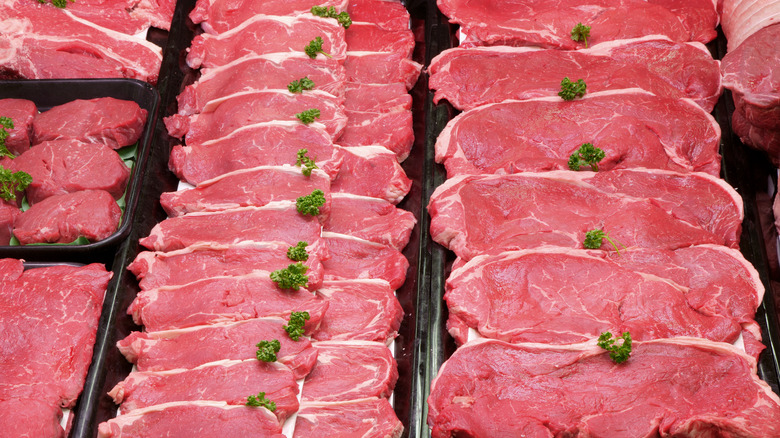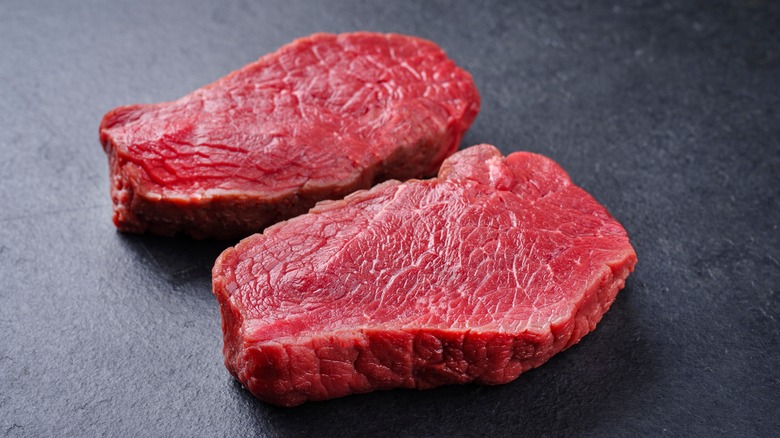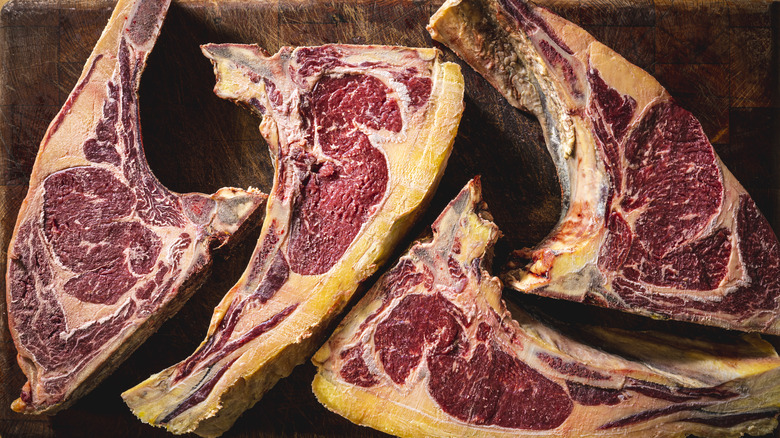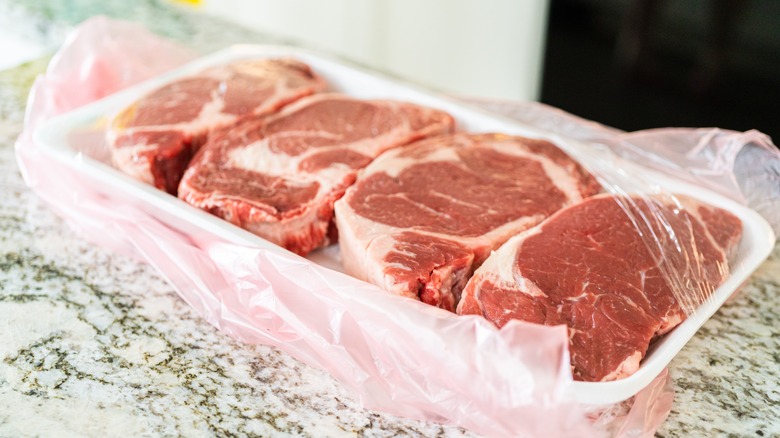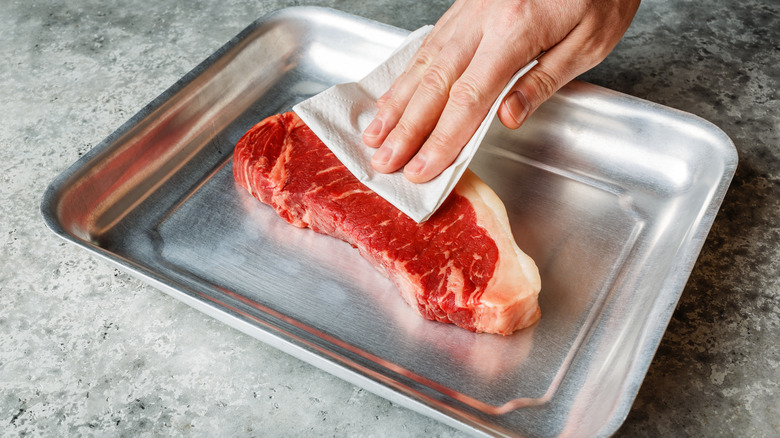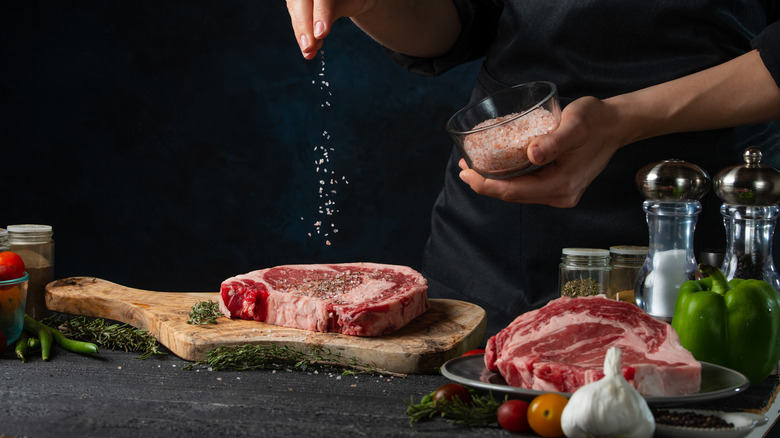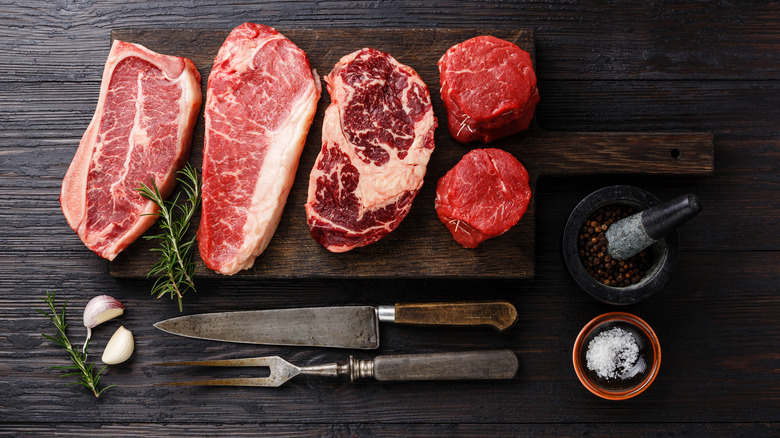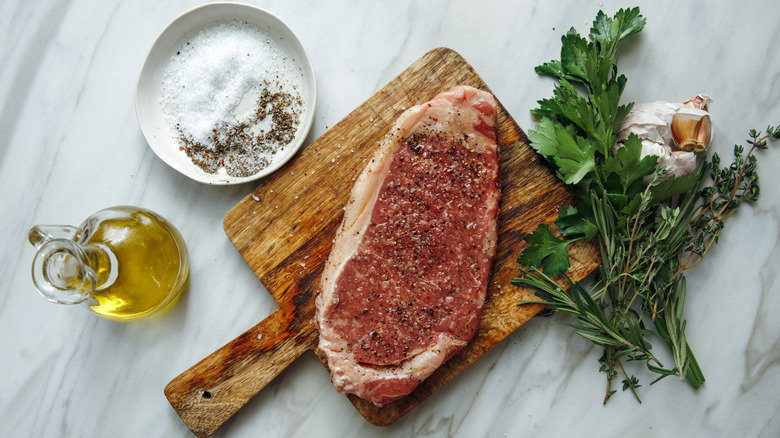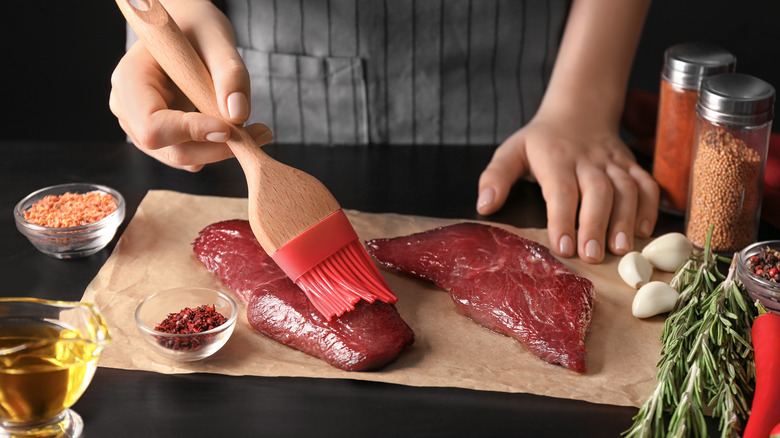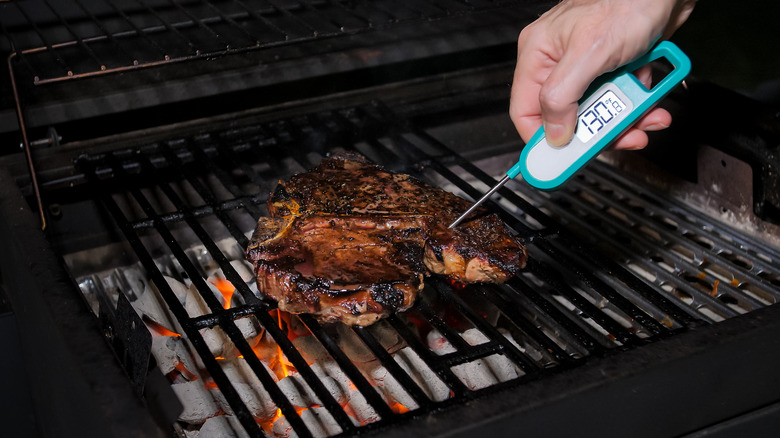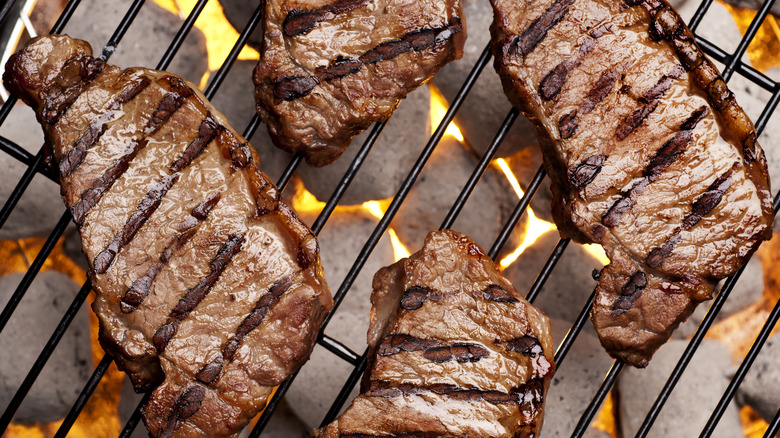Here's How Experts Say To Prepare Your Steaks For Grilling
When it comes to grilling, how many of us venture out of our comfort zones? Most people often prefer to leave the tenderloins, ribeyes, and filets to steakhouses to do the grilling and might have the impression they're less forgiving and more demanding to get right, not to mention many of them are expensive cuts of steak that imply a greater loss if messed up. It's only natural to feel this risk, so I've consulted the professionals to assuage your fears. If the thought of preparing steaks for the grill overwhelms you, take comfort in knowing it's more straightforward than it appears –– most of the preparation needed for excellent results can be done right before grilling.
When I asked chef and food blogger Corrie Duffy from Corrie Cooks what he loves about this method, he responded, "Grilling steak brings out rich, smoky flavors and creates a delicious crust. The high heat sears the outside while keeping the inside juicy, making it a perfect cooking method for a flavorful, satisfying meal." Who's going to say no to trying that? Plus, grilling steak doesn't have to revolve around T-bones and fancy cuts –– these experts share that several steak cuts work. Avoid the most common mistakes when grilling and check out the experts' advice, including Chef Amy Hand from The Skillful Cook, Chef Alfredo Nogueira of Cane & Table, Jasmine Peterson, a nutritionist from NextLuxury, and Corrie Duffy, on how to perfectly prepare your steaks.
Pick the best cuts of steak for grilling
Your first step to grilling the perfect steak begins before you've even set foot in the kitchen. When selecting beef at the supermarket, it's good to know that some cuts of steak are better for grilling while others are destined for braising. If you're debating behind the meat counter, Chef Amy Hand from The Skillful Cook shares, "Ribeye, New York strip, and T-bones are all great for the grill. They have an even marbling of fat that will melt on the grill and result in a very tender texture with very little cooking."
Duffy concurs, "Ribeye is known for its rich marbling, which makes it incredibly flavorful and juicy. The New York strip offers a good balance of tenderness and flavor, with a bit less fat than a ribeye. T-bone steaks give you the best of both worlds: a tenderloin on one side and a strip steak on the other."
Chiming in from one of New Orleans' top restaurants, Cane & Table, Chef Alfredo Nogueira adds, "I like them all, but my approach can be different for each, and some are better suited for larger crowds than smaller groups. For example, a T-bone is perfect for a night with just my family since my wife and daughter love the filet side, and I get the whole strip, but if I'm cooking for a crowd, I may prefer a larger format like a Ribeye or Tri tip so I can slice and serve."
Use the ideal steak thickness for your purpose
Another important consideration before grilling your steak is its thickness. You might be tempted to grab the thickest steak available because bigger is better, right? Not quite. For Nogueira, "It totally depends on the cut and the dish." Proving that thinner cuts can also shine on the grill, he shares a Cuban steak recipe called Bistec a la Palomilla, featuring thinly sliced sirloin that is quickly seared and plated with sautéed onions and lime juice.
If you need to put a number on it, Jasmine Peterson, a nutritionist from NextLuxury, advises, "Aim for steaks that are about 1 to 1 ½ inches thick. This thickness allows for a good sear on the outside while keeping the inside juicy and tender." Hand elaborates, " This allows you to cook the center of the cut to medium rare while also achieving a delicious caramelized crust on both sides." A thicker steak also tends to have more marbling, those mouthwatering ribbons of fat that result in a more buttery slab of meat.
You should also anticipate how to correctly grill your steak based on its measurement. Thinner cuts of skirt or flank are popular in Asian and Mexican dishes, like grilled steak fajitas, but generally need more time, lower temperatures, and continuous supervision to avoid a chewy meal. Thicker cuts like ribeyes and T-bones are best grilled rapidly at a sizzling heat.
Choose dry-aged steaks for more flavor
If the price tag on an aged steak has ever made you pause, you're not alone. Aging requires extra supervision, expensive equipment, and expert techniques that you just won't see at your local grocery store, where most of us go for convenience and affordability. So, when it comes to grilling, is it worth the extra visit to a speciality butcher for an aged steak? For Hand, "An aged steak has a very unique flavor so it really depends on your personal taste. If you like your meat really stringy and gamey then an aged steak will be right up your street." Peterson comments, "Dry-aged steaks, in particular, offer a more intense, nutty flavor." Like a funky cheese, aged steaks are definitely an acquired taste.
As the beef loses moisture during the aging process, Duffy explains that the meat's natural enzymes break down the muscle fibers, tenderizing the cut and concentrating its inherent meatiness. If you opt for an aged steak, Nogueira recommends, "Certain cuts, like Ribeye, Strip, and T-bone, just age so nicely, and the aging really enhances the beef flavor." But be advised –– an aged steak might not be for the casual backyard barbecue. The meat's texture, weight, and properties have changed due to water loss, meaning it's slightly trickier to grill a dry-aged steak than your average deli counter cut. Either way, Duffy concludes, "If you're looking to elevate your grilling game, opting for an aged steak can make a noticeable difference."
Keep your steak refrigerated until prep time
Most of us know we should give steak some time to sit at room temperature before grilling, but do you know why? For many, the key to a killer steak is getting the inside to medium rare without burning the outside, but this can only be accomplished if you temper the meat before it hits the grill. Peterson recommends removing the steak from the fridge about 30 to 40 minutes beforehand to ensure more uniform cooking. If you skip this step, Hand warns, "A cold steak will take longer to cook and is less likely to form a strong crust before the center is cooked." Your steak also loses moisture and becomes tougher the longer it takes to finish on the grill.
Duffy adds, "[Steaks] can be stored in the fridge for up to three to five days if properly wrapped. It's crucial to keep the steak cold to prevent bacterial growth. If you've bought a steak but don't plan to cook it within a few days, consider freezing it."
Tempering isn't an exact science; it's more like letting the beef breathe, and can vary based on the season, climate, or whether you're defrosting the steak. As Nogueira puts it, "I like to remove it as soon as I start my prepping so that I can get it to start tempering. The closer the steak is to room temperature when you go to grill it, the better."
Pat the steak dry
Steaks are often a bit moist from sitting in their natural juices in the package, and something as simple as patting the meat dry works wonders, taking your grilling skills up a notch in taste and aesthetics. Nogueira points out, "To get the best browning, you need a dry surface." Meanwhile, Hand admits, "Patting the steak dry before grilling is not strictly necessary but if you want a good crust, I recommend it." If such a quick step can help achieve better results, why skip it?
If you thought a steak's sear was just appealing on a visual level, think again. For Duffy, "This step ensures a nice crust forms on the steak, enhancing both the texture and flavor." The second you set your steak down on the grill, a chemical reaction transforms the proteins and sugars on the meat's surface, altering its color, aroma, and taste. Known as the Maillard reaction, this browning is the same reason why caramelized onions, crispy potatoes, and grilled vegetables are so delightful. If you don't pat your steak dry before setting it on the grill, Hand explains that any moisture on the meat's surface will need to evaporate before caramelization can take place. As the meat is already cooking, you'll be wasting precious time and the potential for what Peterson describes as "a better sear and a crispier crust."
Don't salt your steak too early
When it comes to preparing your steak before grilling, salt is the most important seasoning you're going to use. Nogueira explains, "It is ideal to salt the steak when you take it out to temper so that the salt can really permeate the steak." Hand agrees," I like to season my steak just after I take it out of the fridge." No more worrying about salting your steak overnight, Duffy reassures us that a healthy sprinkling briefly before grilling is already enough time for it to stick to the meat and work its magic. While you're prepping the grill and assembling the rest of the meal, the salt will be pulling moisture out of the steak, creating a tenderizing brine to be reabsorbed by the meat.
Peterson details how preemptively salting your steak could actually do more harm than good. "Seasoning too early can draw out moisture," she says, "while seasoning right before grilling ensures the salt doesn't pull out too much juice." She concurs with our other experts, proposing to salt the steak about 40 minutes before grilling. Given that some salt will naturally fall in between the grill grates, douse your steak with a generous amount of sea salt or kosher for umami goodness.
Stick with simple seasonings
When you're craving a savory steak off the grill, there's no need to go overboard on the seasonings. Duffy admits, "The best seasonings for grilling steaks are often the simplest. A generous amount of salt and freshly ground black pepper is usually enough to enhance the steak's natural flavors. The key is to complement the meat without overpowering its flavor." Hand agrees, adding, "Don't be shy with the quantities either."
Salt is nature's own flavor enhancer and meat tenderizer, but have you ever wondered why it always goes in tandem with black pepper? The beloved spice is also a flavor enhancer, rich in a component called piperine that explodes with piquancy when grilled, igniting your taste receptors and pairing wonderfully with meat. Peterson comments, "Stick to kosher salt and freshly ground black pepper." Using a coarsely ground pepper also guarantees more flavor and fewer chances of burning when seared on a hot grill, which could quickly take the taste from pungent to bitter.
Apart from the holy duo of seasonings, Duffy adds, "You can also add garlic powder, onion powder, or smoked paprika for additional depth. Fresh herbs like rosemary or thyme can be added to the grill or used in a marinade." Nogueira takes a similar stance, admitting "Most of the time, I like to keep it simple with salt and black pepper, but some cuts are great marinated." Two of his favorite recipes with steak marinades are Korean-style short ribs and flank steak tacos.
You don't need to trim the fat
You know your steak's marbling guarantees a juicier, more buttery result, but what about the fat around the edges? All cuts of beef can develop three forms of fat: marbling (known as intramuscular fat), as well as subcutaneous and inter-muscular fat. These last two types are the visible chunks on the meat's exterior, easily sliced off if you're preparing a stew or rice dish.
Regarding whether to trim the extra fat before grilling, the experts advise us not to give it too much importance. Nogueira simply states, "Kind of a personal preference." Hand points out, "If you are getting your steak from a supermarket or butcher, it will likely already be trimmed and ready to cook as is. If you cut off any additional fat, you are losing out on a lot of flavor. It's also a key factor in keeping your steak moist..." Duffy explains these fats can act as a barrier against moisture loss, rendering down and basting the steak as it cooks.
Peterson proposes leaving about a ¼ inch around the meat, trimming any of the loose bits that might slip and cause flare-ups on the grill. Duffy adds that you can use a small knife to make some slashes in the fat cap. Known as scoring, "This allows the fat to render more evenly and helps the steak maintain its shape on the grill."
Brush your steak with a bit of oil
A little oil goes a long way to achieving a succulent steak dinner. Peterson advises, "Brush the steak lightly with oil before grilling to prevent sticking." The oil acts as a lubricant to help you flip and remove the steaks from the grill, saving you from any unnecessary scraping that could destroy bits of the tasty crust. You might be tempted to oil the grill directly, but the grates will always reach higher temperatures than the meat, quickly burning the oil and possibly provoking smoke and flare-ups. Similarly, you don't want to go overboard when brushing the steak with oil. Not only will it result in oily meat, but excess drippage on the grill could send flames back to char the steak or (God forbid) your face.
You should also choose your oil wisely, given that they all have varying smoke points and begin to burn at different temperatures. Extra virgin olive oil has a relatively low smoke point, meaning it could burn pretty quickly on a searing grill, obstructing your view while the taste becomes bitter. Duffy likes to use high smoke point oils like canola or vegetable oil for a nice, even sear. You could brush the steak with clarified butter to prevent sticking and get those impressive grill marks, or follow Duffy's advice and "finish [your] steaks with a pat of butter during the last minute of grilling for added richness and flavor."
Have a thermometer handy
Perhaps one of a grill master's most important tools is a thermometer. Before grilling any steak, Chef Nogueira recommends getting your probe thermometer ready, though you don't need to check if the meat has reached room temperature. Hand agrees and adds, "As long as it has been out for an hour, it will be warm enough."
Rather, Nogueira suggests inserting the thermometer into the cut of beef once you've placed it on the grates, then to "set a temperature and chill." Using a thermometer to gauge your steak's temperature saves you from having to cut into the meat to check its doneness, losing all those precious juices you've worked so hard to keep. Cutting into the steak is also an unreliable way of checking for doneness –– the bright red juices that emerge might convince you it needs more time, when you're really just overcooking it.
Using a meat thermometer helps to ensure the steak reaches your desired doneness, but also that the beef has reached a safe internal temperature. The USDA has established 145 F (plus three minutes of rest time) as the minimum temperature for beef and steaks, which in doneness terms is around a medium. If you prefer your steak bloodier, you could stay between 130 F and 140 F for medium rare.
Prepare the grill before you start
A final consideration before preparing your steaks is what type of grill you'll use. Our experts shared their thoughts on the most common types of grills: charcoal versus gas. Between the two, Nogueira declared, "Charcoal, no question." Duffy explained, "Both charcoal and gas have their benefits. Charcoal gives a smoky flavor and higher heat, while gas is convenient and provides more control." A gas grill may be more manageable for weeknight dinners or low and slow barbecuing, but Hand notes, "I prefer charcoal over gas grills because they add a distinctive smokey flavor to the meat that the gas lacks." While it depends on your preferences and needs, Peterson reassures us that "Both can produce excellent steaks."
If you opt for the charcoal grill, Nogueira shares his favorite preparation method: "I like to make two different zones on the grill. One very hot, with coals directly beneath and one with no coals so that I have a lot of control." He continues, "I have been really into reverse searing everything, but primarily steaks and chicken. I start everything on the side without coals...Then when the protein reaches the desired temperature, I flip it to the hot side to sear, take it off to rest, and then serve." Hand concludes, "450 degrees Fahrenheit is the perfect temperature for grilling a juicy steak. You can also add some wood to the mix like maple or oak to amp up that flavor profile."
